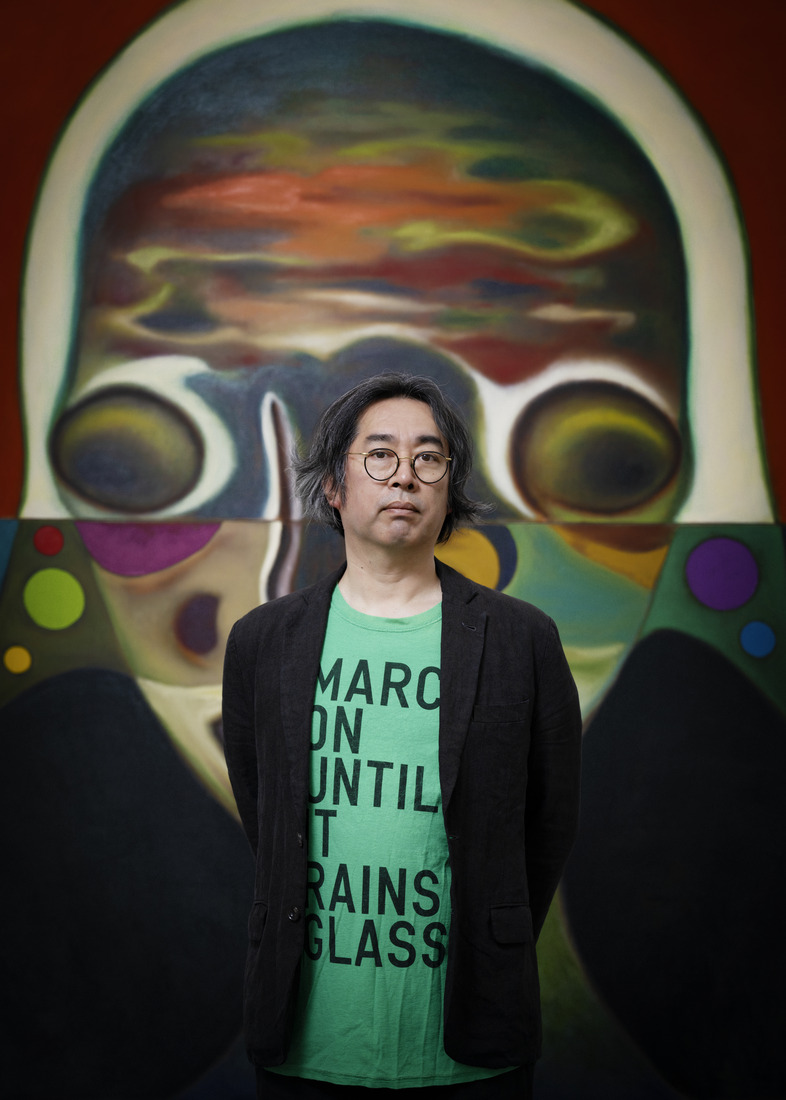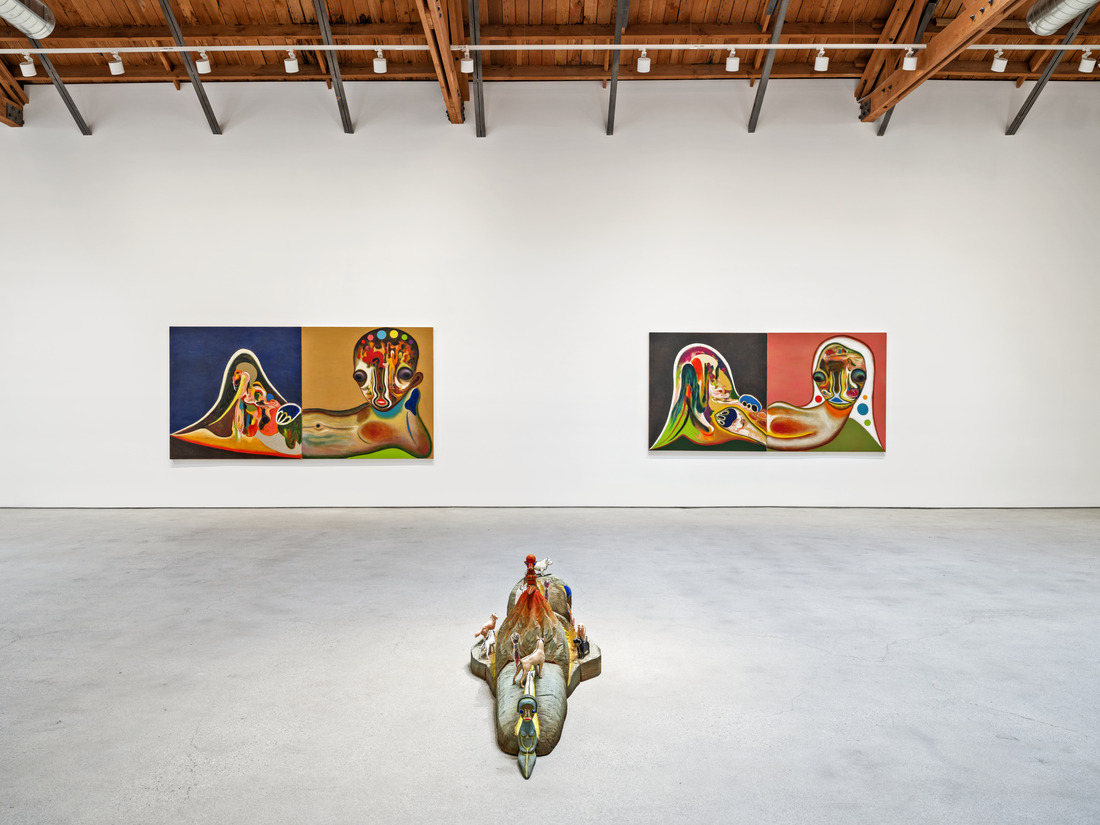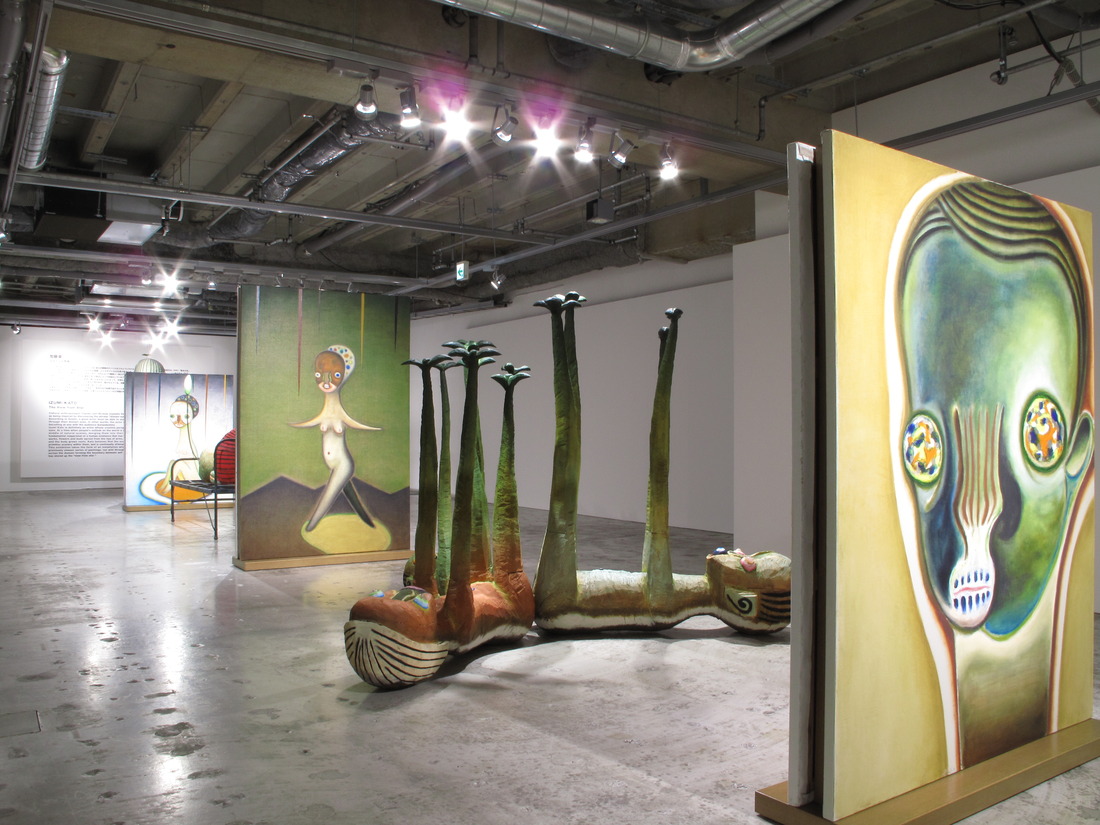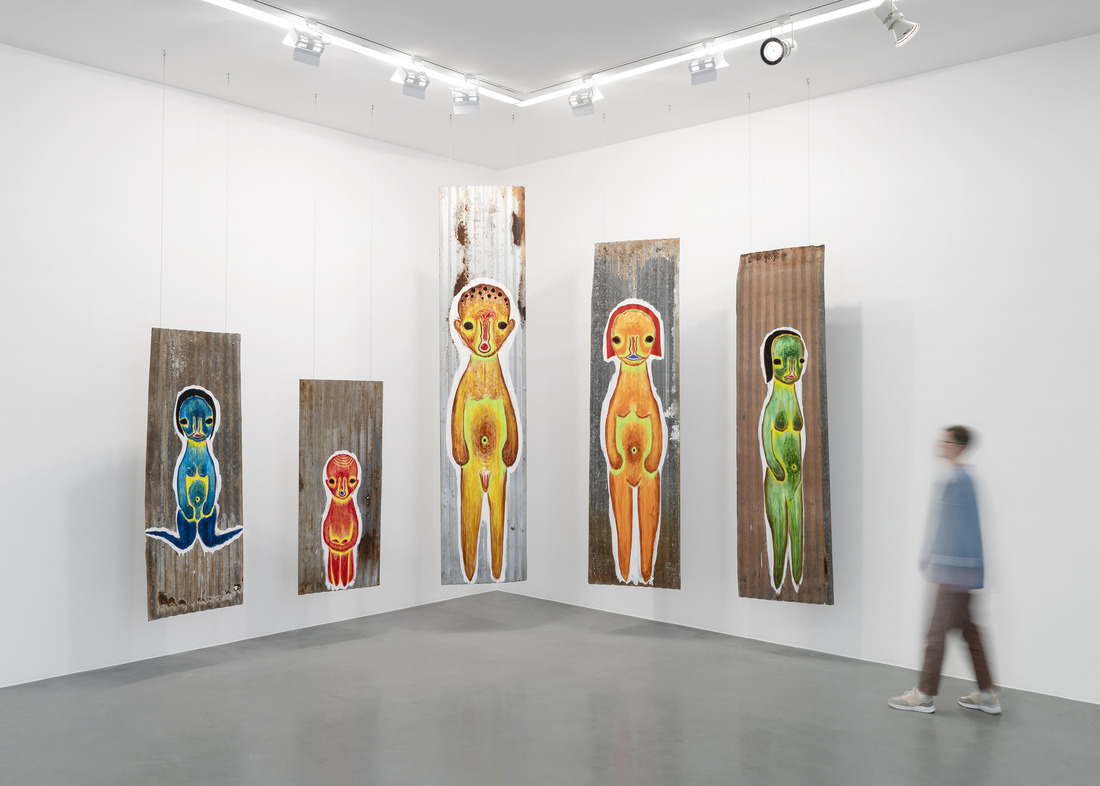Izumi Kato, born in 1969 in Shimane Prefecture, Japan, has established a distinctive presence in the art world, breathing life into a realm that exists on the border between the tangible and the ethereal. His diverse body of work, encompassing paintings, sculptures, and installations, occupies a liminal space where physical and spiritual realities seamlessly merge.
Presently dividing his time between Tokyo and Hong Kong, Kato draws inspiration from the cultural richness of his birthplace, nestled amidst the mountains and seas of Shimane, home to the venerable Izumo Ōyashiro shrine of Shintoism. Describing painting as the cornerstone of his artistic practice, Kato embarks on an immersive exploration of bold and contrasting colors. His canvases are populated by figures that defy conventional norms—children with unconventional faces, embryos with fully developed limbs, and characters with bulbous heads on slender, graceful bodies.
Kato’s artistic journey commenced at Musashino Art University, where he graduated from the Department of Oil Painting in 1992. Influenced by luminaries such as Francis Bacon, Vincent van Gogh, and Itō Jakuchū, his early works, often resembling embryos or fetuses, gained recognition in group exhibitions in Tokyo in 1995.
The artist made his international debut around 2004 when he ventured into sculpting. Notably, in 2007, Kato became the first young Japanese artist to be invited to the prestigious 52nd Venice Biennale, curated by Robert Storr, marking a pivotal moment in his career.
Employing an intuitive approach, Kato applies pigments directly with his hands, creating textures as raw and primal as the themes he explores. This fervent exploration extends beyond canvases to include textiles, wood, and stone, broadening his artistic vocabulary.
As an ardent fisherman, Kato seamlessly integrates skills like stitching, knotting, and carving into his practice, infusing his sculptures and installations with a tactile and organic quality. The resulting creatures from Kato’s imagination can either loom large over viewers or delicately inhabit corners, blurring the boundaries between reality and fantasy.
Kato’s creatures, with their haunting anonymity and elemental forms, beckon viewers to connect with a primal, universal humanity grounded in intuition. Evoking totems and animistic beliefs, his enigmatic beings extend an invitation to recognize oneself in the mysterious dance between physical and spiritual dimensions. Izumi Kato continues to captivate and challenge audiences, transcending cultural boundaries with his unique blend of intuition and artistic innovation.

An Interview with Izumi Kato
By Carol Real
How has your upbringing in Japan’s Shimane Prefecture influenced your artistic sensibilities and subject matter?
I often become aware of the influence of my upbringing in Shimane Prefecture when being interviewed aboard.
The Shinto belief in Yaoyorozu no Kami and animistic religious views have influenced my work. In my hometown, it was common to use ghost stories in children’s education. For example, when I was a child, my parents said that the night sea was haunted by a female-headed and snake-bodied ghost, and I was so scared that I stopped going to the sea at night. Now as an adult, I understand that it was a story passed down from generation to generation to protect children from the danger of the sea at night. There were many such stories in my childhood, and I think they unknowingly influenced my artwork.
Mr. Kato, your artwork is known for its unique and enigmatic creatures. Could you describe what inspires these figures?
In the end, I’m not trying to depict any specific figure; it’s more like the process of a child’s drawing, starting with dots and lines and gradually evolving into humanoid figures and colors over the past 20 years. Therefore, there isn’t anything specific that inspires me. The current paintings have emerged naturally from my interactions with my paintings.
You’ve described your figures as expressions of consciousness. Can you delve into the thought process?
I want to create good paintings. Right now, I am deliberately including information that does not specify a particular figure, conversely making it about no one and everyone. Since viewers are human, there is a natural tendency to feel various emotions and attachments toward human forms, which I find interesting.
Animals and flowers may be cute or beautiful, but people don’t scrutinize them as much.
As for my thought process, hmm… I can’t explain it well.


You mentioned that your figures are a blend of primitive art and science fiction. How do you balance these influences in your work?
I don’t intentionally try to balance them. Perhaps because the past and the future are connected in some way; viewers of my art might naturally perceive a balance between the past (primitive) and the future (science fiction).
What role does intuition play in your artistic process, especially when you create these mysterious beings?
Intuition is the most crucial element. During my creative process, my mind is always working like a supercomputer, making judgments and creating within a short, almost instantaneous timeframe.
It’s very important to make the decisions myself, as relying on verification or examination would slow down the process. If anything, I would say that I have trained for many years to develop that intuition.
Could you share your thoughts on the spiritual aspect of your art, particularly the belief that everything contains a spirit?
I believe the unique culture and philosophy of my hometown in Shimane Prefecture and the concept of Yaoyorozu gods have influenced me naturally.
Although I’m not particularly religious, this animistic belief from my hometown became more and more apparent to me. Japan is a small island nation, but my hometown is not Tokyo or Kyoto—it’s a very rural place, far from Tokyo, with many myths, ghost stories, and legends.
I think the belief in Yaoyorozu gods, which influences me, serves as a reminder to humans that we tend to get carried away, and having non-human entities as gods or superior beings is a way to admonish ourselves. I believe this philosophy has ultimately influenced my artistic expression.
*Yaoyorozu no Kami (八百万の神): In Shinto, an ancient Japanese religion that refers to the myriad of enshrined deities. From ancient times in Japan, it is believed that gods reside in everything, from natural phenomena and objects such as the sun and moon to wind, houses, and even toilets. This belief led to the custom of venerating countless gods, collectively known as “Yaoyorozu no Kami” in Japanese culture.


Your practice involves working with various mediums, including painting, sculpture, and found objects. How do these different forms of expression complement each other in your work?
These different forms of expression mutually influence each other. When I faced a creative block in painting, I turned to making wood sculptures. Wood sculpture allowed me to break free from the slump, and subsequently, my paintings started influencing sculptures, sculptures started influencing paintings. This leads to the current state of my work.
Since I see myself primarily as a painter, ultimately, I use various materials and mediums to enrich my artistic vocabulary for paintings.
Could you elaborate on your use of plastic models and how they have influenced your latest series?
The “Plastic Model” series is interconnected with various previous works but has a slightly fresh perspective. I not only incorporated existing plastic models in my sculptures but I eventually created my original plastic model kit. By turning my stone sculptures into plastic models, people can build and assemble their own versions of my work. This is a new concept in my practice that I find highly interesting. Additionally, the original plastic models conceptually connect my stone sculptures to cast aluminum or bronze artworks, making them one of the pivotal series in my artworks.
On that occasion, I also debuted plastic model kits that I designed myself. It is shaped after one of my stone sculptures and people can build and assemble their own versions of my work.
You mentioned that your latest series involves “parasitic plastic models.” What does this term mean in the context of your art?
The title “Parasitic Plastic Models” from my solo exhibition at the Watari Museum of Contemporary Art in Tokyo in 2022 signifies the vintage plastic models attached to my works, creating an image of parasitism.
However, in the case of the plastic model kits, the meaning of ‘parasitic ’ reverses as my work or the concept lives in the plastic models.
Your work is distinct from other contemporary Japanese artists. What sets it apart, and what messages do you aim to convey?
There isn’t a specific message. I believe it’s better if people interpret my work the way they want to. I’m glad to hear that my work stands out from other contemporary Japanese artists, as I don’t create art to express my national identity.
What’s crucial is making something original, something that only I can create.
Your collaboration with curator Robert Storr opened doors for you internationally. How did this opportunity impact your career?
Being invited to the curated exhibition at the Venice Biennale in 2007 had a tremendous impact. I am sincerely grateful to Mr. Storr.
As an unknown Japanese artist, it was a special experience to have my paintings seen and appreciated by art professionals worldwide. Mr. Storr, being a curator specializing in painting, presented my work alongside the world’s top painters in the Italian Pavilion, which was both exciting and confidence-boosting.
It was also significant that after that exhibition, I was able to make a living as an artist.
Your work often presents dark and mutable themes. What emotions or ideas do you hope viewers take away from your art?
I want the viewers to take away any feelings and thoughts from seeing my work freely. I believe it’s more significant how viewers feel when they encounter my work than the message I intend to convey through it. I don’t have a particular message or theme for each work, but I believe that the determination to live is naturally reflected in my work.


How do you approach the process of painting on stone or other materials, and how does it differ from traditional canvas painting?
I use the natural shape of the stones without carving, then combine and arrange them until I form the image of the artwork. About 80% of the work is completed at this stage. Unlike canvas, stones contain a lot of information, such as their color, grain, and surface texture. It’s like collaborating and engaging in a dialogue with the information inherent in the stones. On the other hand, working with canvas feels like creating a painting from scratch.
Your work has been featured in various exhibitions worldwide. Do you have any favorite moments or experiences from these shows?
I find it very refreshing and interesting that people from different cultures, races, and life experiences around the world can view my works and gain inspiration or contemplation from them.
You’ve mentioned that you might change or destroy your style in the future. What drives your desire to evolve as an artist?
I want to burn out and die. I genuinely wish to use up my abilities and energy and die. My life burns and shines most brightly when I’m creating artwork. I want to dedicate as much time as possible in my life to creating good artwork.
Your recent success in the art world has been remarkable. How does it feel to see your work gaining recognition globally?
I don’t think my works have gained global recognition yet. Instead, I believe there’s a long way to go in terms of my artistic potential.
While I’m glad to receive recognition from the outside world, I consider it more important to create works that are good in my perception.
What do you find most rewarding about your career as an artist, beyond commercial success?
It is personally gratifying when I sense that my work has improved; such recognition holds more value to me than external evaluations.
Could you share your perspective on the relationship between the academic and commercial aspects of the art world?
Speaking from my viewpoint in Japan and Asia, I feel the commercial aspect is currently strong. Perhaps having both aspects in a well-balanced manner would be the best. Good works in the academic sense may face difficulties in sales, and there are cases, where works not appreciated academically, are commercially successful. I am somewhat concerned about the current situation.



How do you navigate the fine line between maintaining your artistic integrity and meeting market demands?
To some extent, I strike a balance by creating works with market appeal, yet I still freely create what I want. Especially since there are no strong demands from the galleries that represent me, I’m grateful that I can create and present works without any commercial constraints.
I don’t prioritize meeting market demands, as it doesn’t guarantee future success. I believe in the importance of persistently creating art with self-confidence.
Could you share your thoughts on the role of art in contemporary society and its ability to provoke thought and reflection?
Art serves the role of ensuring human survival. For example, humans create nuclear weapons, but I think art plays a role in discouraging the impulse to press the button to use the weapon. I believe art also contributes to preserving humanity, no matter how society changes. It aids in fostering an appreciation of qualities that define us as humans, acting as a safeguard against self-destruction.
What challenges have you encountered on your artistic journey, and how have you overcome them?
I struggled a lot when I was young due to poverty. In my twenties, I pursued a career as a musician but failed. Even in my thirties, I was still struggling financially. However, I felt strongly that I should bet on my life as an artist, even if I didn’t succeed. Thanks to that determination, I was able to continue creating even in poverty. I think that I’m very lucky to be able to live as an artist now.
What advice would you give to emerging artists who aspire to achieve recognition and success in the art world?
Nothing more than to do your best.
What do you hope to achieve with your art, both in terms of personal growth and its impact on society?
I aspire to create works at the level of great painters I admire, such as Vincent Van Gogh, Francis Bacon, and Jakuchu Ito. I want to produce works that are at the same level or even surpass them in my own way. I value the process of creating in my own approach.
Do you have any upcoming projects or exhibitions that you’re particularly excited about?
While there are various projects in the coming years, currently, I’m looking forward to a two-person exhibition with my Mexican artist friend, Bosco Sodi, in a temple in Kyoto in October 2024. Additionally, I’m excited about having a solo exhibition at the Shimane Art Museum in my hometown in 2025.
Apart from these, I will be showing new works at a solo exhibition at the newly opened Perrotin Gallery in LA in February and another solo exhibition at Perrotin Hong Kong in March. It’s my first visit to LA, and I’m thrilled to present new works.
Lastly, what message or feeling do you hope viewers experience when they encounter your art?
I want them to view my works freely without preconceptions.
Editor: Kristen Evangelista